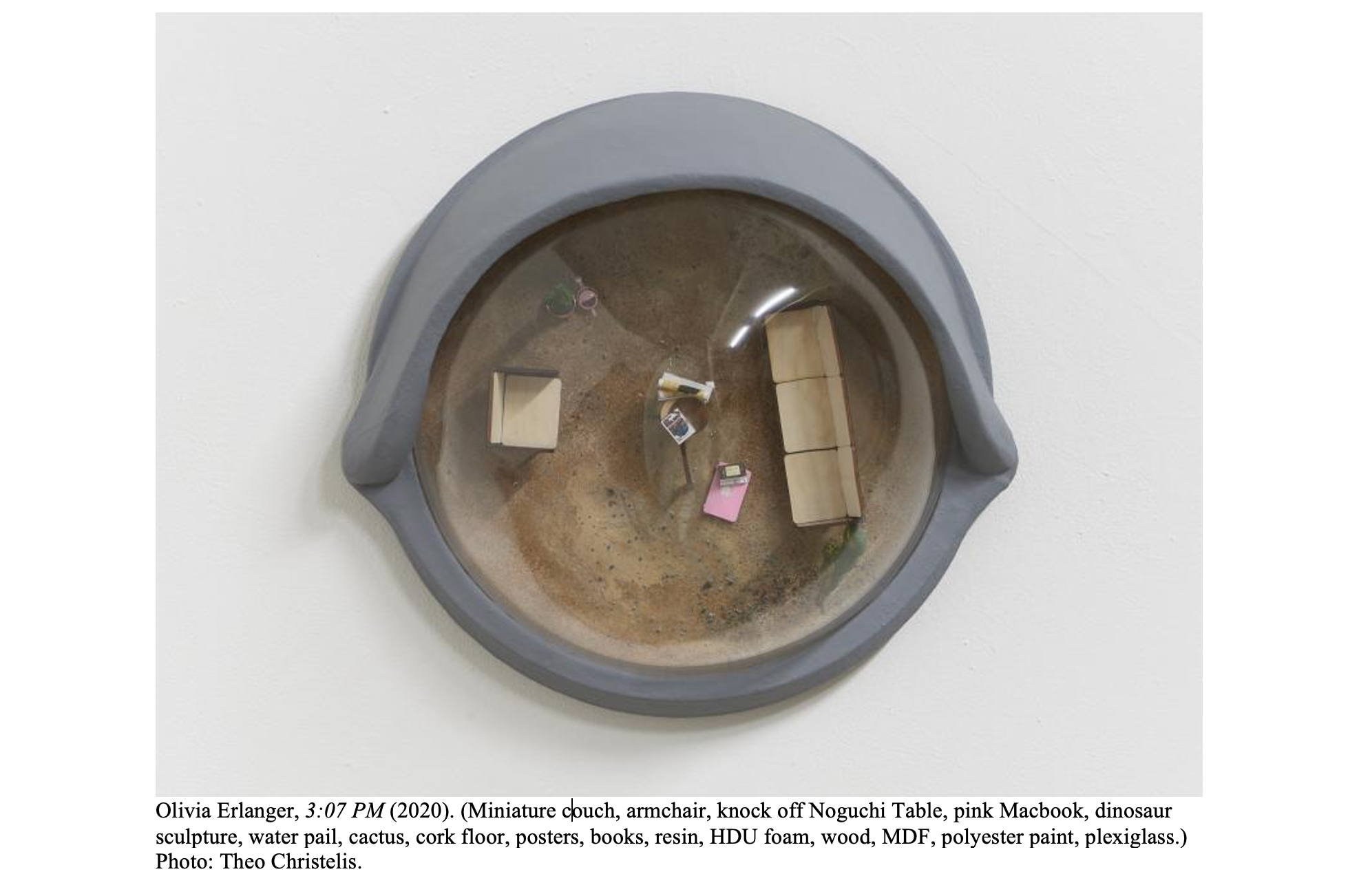The Vibe-Building of Olivia Erlanger
Anna De Filippi
During the COVID-19 lockdown in 2020, the New York based artist Olivia Erlanger began a series of artworks that would later form the exhibition Home is a Body.[1] Moving around her small apartment, she became interested in the “ghost of [her own] presence,” how a body “imprints” a room, and what the “use value of a room is when empty.”[2] She conceptualised these eye-shaped globes of apartment interiors, each titled at different times of the day, as “reverse apartment peepholes.” The “absence of action” was important to her, without any figural representation – but, as the title’s maxim intuits, not without a body.
In what sense can we speak of a body here? Delicate doll house miniatures dot Erlanger’s interiors – Coca Cola bottles, a guitar, a paint set, a pink Macbook, a weightlifting set, a knock off Noguchi table, books – all objects of jouissance, pointing to the bodies that use and chose them, in their absence. Erlanger’s subtraction of the figural body brings to mind Lacan’s discussion of ancient burials in Radiophonie – “The empty set of bones is the irreducible element from which all the other elements are ordered, the instruments of jouissance, necklaces, goblets, armaments: more like sub-elements to enumerate jouissance than to make it re-enter into the body.”[3] Here, Erlanger’s definition of the body seems to be these very sub-elements, residues of jouissancestyles[4] that she at once makes visible and humorously relativises.
“A vibe depends on the principle that I am seen enjoying/I enjoy being seen” – following Lacan in Seminar xi, Cyrus Saint Amand Poliakoff points us towards the way jouissance is styled by the gaze.[5] Considering this logic, in Erlanger’s vibe-building, what is the function of the eye-shaped frames? She could have chosen many other ways to frame these interiors. By choosing an eye, Erlanger brings the gaze that styles jouissance hors champ back into the frame.
In a first instance, the viewer is placed in the position of surveillance, studying each bird-eye interior, like scrolling Instagram but made art. Yet the eyes also look back out at the viewer, subverting the impulse to approach these interiors as a “spectacle” to possess – the lure of i(a) – thereby implicating the viewer’s own jouissance.[6] Moreover, the artist chose to hang each artwork at different heights, not at eye-level. The viewer must bend and extend to visually capture these micro-worlds – or be captured by them.
References
[1] Erlanger, O., Home is a Body, Soft Opening, London, 1st October – 7th November, 2020. http://www.softopening.london/exhibitions/home-is-a-body. See also, Erlanger, O., “The Fantastic Real,” in Tank Magazine, available online. [Erlanger’s work more broadly explores the uncanny and the world-building of science-fiction, a genre she turned to when confined to interiors as an adolescent after an accident.]
[2] In conversation with the artist, interview conducted by the author on Zoom, December 2023.
[3] Lacan, J., Radiophonie, in Autres Écrits, Paris/ Seuil, 2001, p. 412. [Unpublished in English, Blog Team Translation]
[4] Cf. Poliakoff, C.S.A., “Vibe is Jouir,” Published on this Blog.
[5] Ibid.
[6] Cf. Lacan, J., Television: A Challenge to the Psychoanalytic Establishment, Transl. Hollier, Mitchell & Krauss, New York: Norton, 1990, p. 86. Also, Miller, J.-A., “The Sovereign Image,” The Lacanian Review 5, 2018, p. 47.

